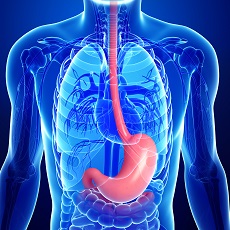

New on the MedlinePlus Allergy page:
05/29/2018 12:06 PM EDT
Source: National Library of Medicine - 

Eosinophilic Esophagitis
Also called: EoE, Eosinophilic OesophagitisWhat is eosinophilic esophagitis (EoE)?
Eosinophilic esophagitis (EoE) is a chronic disease of the esophagus. Your esophagus is the muscular tube that carries food and liquids from your mouth to the stomach. If you have EoE, white blood cells called eosinophils build up in your esophagus. This causes damage and inflammation, which can cause pain and may lead to trouble swallowing and food getting stuck in your throat.
EoE is rare. But because it is a newly recognized disease, more people are now getting diagnosed with it. Some people who think that they have reflux (GERD) may actually have EoE.
What causes eosinophilic esophagitis (EoE)?
Researchers are not certain about the exact cause of EoE. They think that it is an immune system/allergic reaction to foods or to substances in your environment, such as dust mites, animal dander, pollen, and molds. Certain genes may also play a role in EoE.
Who gets eosinophilic esophagitis(EoE)?
EoE can affect anyone, but it is more common in people who
- Are male
- Are Caucasian
- Have other allergic diseases, such as hay fever, eczema, asthma and food allergies
- Have family members with EoE
What are the symptoms of eosinophilic esophagitis (EoE)?
The most common symptoms of EoE can depend on your age.
In infants and toddlers:
- Feeding problems
- Vomiting
- Poor weight gain and growth
- Reflux that does not get better with medicines
In older children:
- Vomiting
- Abdominal pain
- Trouble swallowing, especially with solid foods
- Reflux that does not get better with medicines
- Poor appetite
In adults:
- Trouble swallowing, especially with solid foods
- Food getting stuck in the esophagus
- Reflux that does not get better with medicines
- Heartburn
- Chest pain
How is eosinophilic esophagitis (EoE) diagnosed?
To diagnose EoE, your doctor will
- Ask about your symptoms and medical history. Since other conditions can have the same symptoms of EoE, it is important for your doctor to take a thorough history.
- Do an upper gastrointestinal (GI) endoscopy. An endoscope is a long, flexible tube with a light and camera at the end of it. Your doctor will run the endoscope down your esophagus and look at it. Some signs that you might have EoE include white spots, rings, narrowing, and inflammation in the esophagus. However, not everyone with EoE has those signs, and sometimes they can be signs of a different esophagus disorder.
- Do a biopsy. During the endoscopy, the doctor will take small tissue samples from your esophagus. The samples will be checked for a high number of eosinophils. This is the only way to make a diagnosis of EoE.
- Do other tests as needed. You may have blood tests to check for other conditions. If you do have EoE, you may have blood or other types of tests to check for specific allergies.
What are the treatments for eosinophilic esophagitis (EoE)?
There is no cure for EoE. Treatments can manage your symptoms and prevent further damage. The two main types of treatments are medicines and diet.
Medicines used to treat EoE are
- Steroids, which can help control inflammation. These are usually topical steroids, which you swallow either from an inhaler or as a liquid. Sometimes doctors prescribe oral steroids (pills) to treat people who have serious swallowing problems or weight loss.
- Acid suppressors such as proton pump inhibitors (PPIs), which may help with reflux symptoms and decrease inflammation.
Dietary changes for EoE include
- Elimination diet. If you are on an elimination diet, you stop eating and drinking certain foods and beverages for several weeks. If you are feeling better, you add the foods back to your diet one at a time. You have repeat endoscopies to see whether or not you are tolerating those foods. There are different types of elimination diets:
- With one type, you first have an allergy test. Then you stop eating and drinking the foods you are allergic to.
- For another type, you eliminate foods and drinks that commonly cause allergies, such as dairy products, egg, wheat, soy, peanuts, tree nuts and fish/shellfish.
- Elemental diet. With this diet, you stop eating and drinking all proteins. Instead, you drink an amino acid formula. Some people who do not like the taste of the formula use a feeding tube instead. If your symptoms and inflammation go away completely, you may be able to try adding foods back one at a time, to see whether you can tolerate them.
Which treatment your health care provider suggests depends on different factors, including your age. Some people may use more than one kind of treatment. Researchers are still trying to understand EoE and how best to treat it.
If your treatment is not working well enough and you have narrowing of the esophagus, you may need dilation. This is a procedure to stretch the esophagus. This makes it easier for you to swallow.
- Eosinophilic Esophagitis: Symptoms and Causes(Mayo Foundation for Medical Education and Research)
- Eosinophilic Esophagitis: Diagnosis and Treatment(Mayo Foundation for Medical Education and Research)
- Upper Endoscopy for Kids(North American Society for Pediatric Gastroenterology, Hepatology, and Nutrition) - PDFAlso in Spanish
- Upper GI Endoscopy
 (National Institute of Diabetes and Digestive and Kidney Diseases)Also in Spanish
(National Institute of Diabetes and Digestive and Kidney Diseases)Also in Spanish
- ClinicalTrials.gov: Eosinophilic Esophagitis
 (National Institutes of Health)
(National Institutes of Health)
- Eosinophilic Esophagitis in Pediatric and Adolescent Patients (American College of Gastroenterology)




























.png)











No hay comentarios:
Publicar un comentario